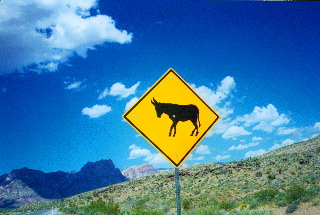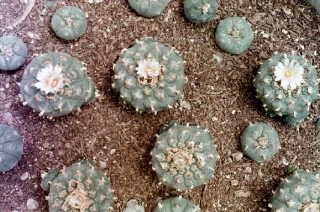 Most of Nevada’s land is under federal control. The Pentagon, Department of Energy, and Bureau of Land Management claim a total area of about 80% of the state. It’s mostly desert, and the desert dois best left alone, so few people seem to care.
Most of Nevada’s land is under federal control. The Pentagon, Department of Energy, and Bureau of Land Management claim a total area of about 80% of the state. It’s mostly desert, and the desert dois best left alone, so few people seem to care.
Some towns, mostly old silver mining camps, persist amid the desert. Horses graze free on the school ball field in Blue Diamond, Nevada. The town sits on a spring in Red Rock Canyon. The one paved road into town passes by a sign that reads: “Population low, elevation high, burrows ‘?’”
 Motorists driving northwest from Vegas on Interstate 95, the state’s second most traveled highway (Route 15, which goes to Los Angeles is first) and pass only a state prison — “picking up of hitchhikers prohibited.” Cactus Springs, one of the few towns on the road, grew up around a small Air Force facility and has only one gas station. The rest is all desert.
Motorists driving northwest from Vegas on Interstate 95, the state’s second most traveled highway (Route 15, which goes to Los Angeles is first) and pass only a state prison — “picking up of hitchhikers prohibited.” Cactus Springs, one of the few towns on the road, grew up around a small Air Force facility and has only one gas station. The rest is all desert.
That there is only one Indian reservation near Vegas, the Moapa River Indian Reservation, belies the fact that this area was once home to a large number of tribes. It’s hard to refute the suggestion that Indians of Nevada were the last to enjoy the effects of the civil rights movement. Few Las Vegas casinos allowed Indians inside until the mid 1970s.
One of the most enduring elements of Indian Nevada is the belief and practice of Peyotism, the mixing of Indian spirituality with Christian beliefs and mescalin cacti. “Peyote itself is sacred, they emphasize, and has many powers to help mankind” writes Omer C. Stewart in his History of Peyotism in Nevada . For true Peyotists, the use of these psychoactive cacti is strictly according to ritual. According to Stewert, “the leader, called the roadman, prays to Jesus, God, Mary and Peyote for guidance during the ritual and for health and wisdom throughout life.”

When eaten and prayed to in the proper ritual context, Peyote helps cure all diseases and reveals many things: the location of lost objects or persons, future events, and proper behavior, among others. Peyote protects from the evil intentions of witches. It brings knowledge for proper living, which includes avoiding alcoholic beverages and always acting according to strict Christian ethics–to love your wife and children and kin, be patriotic and law abiding, and to respect authority, God and elders.
Considering all the medicinal benefits, it may be no surprise that peyote is an endangered plant species and is difficult to find in nature. Purists may scoff, but there are alternatives. Steve Barton, an expert on things cacti, writes that the San Pedro cactus (Trichocereus pachanoi) is more common than Peyote, legal, and can be found in nurseries. Steve instructs us that “t. pachanoi is a slightly tapering cylinder with a small number of ribs (typically 6 or 7), and clusters of 1-2mm spines running along the ridge of the rib and spaced about 1″ apart.” The preferred method of consuming San Pedro is in a recipe he titled crudités St. Pierre. “Slice raw, peeled cactus into sticks. Eat like ‘bitter cucumber spears.’ Add salt, lime-juice and chopped cilantro to taste” says Barton.
Aslynn Ward, a Pagan with an interest in psilocybin mushrooms and mescalin cacti notes that they “have a lengthy and amazing history in human religion and because it is considered a Sacrement; it would be advisable to restrict their use to ritual settings.”
Traveler’s Aid: